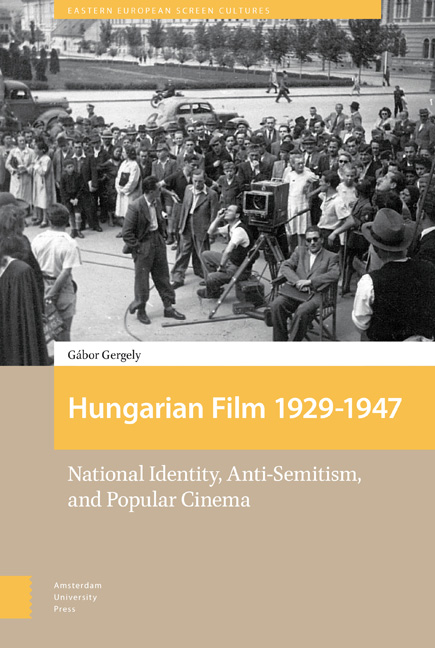Book contents
- Frontmatter
- Dedication
- Contents
- List of Illustrations
- Acknowledgements
- A Note on Accents, Pronunciation, Names, and Spellings
- Preface
- Introduction
- 1 Key Concepts in Pre-1945 Hungarian Cinema
- 2 A Contested Film History
- 3 An Industry Emerges 1931-1935
- 4 Boom, Crisis and Anti-Semitic Reorganization 1936-1941
- 5 From War Boom to Bust 1941-1944
- Epilogue: Industry Reboot and the Myth of a New Start 1945-1947
- Concluding Remarks
- Bibliography
- Index
- Frontmatter
- Dedication
- Contents
- List of Illustrations
- Acknowledgements
- A Note on Accents, Pronunciation, Names, and Spellings
- Preface
- Introduction
- 1 Key Concepts in Pre-1945 Hungarian Cinema
- 2 A Contested Film History
- 3 An Industry Emerges 1931-1935
- 4 Boom, Crisis and Anti-Semitic Reorganization 1936-1941
- 5 From War Boom to Bust 1941-1944
- Epilogue: Industry Reboot and the Myth of a New Start 1945-1947
- Concluding Remarks
- Bibliography
- Index
Summary
I would like to use this space to flag up the importance of Trianon for Hungarian national self-identification. Signed on 4 June 1920, the Treaty of Trianon settled the terms of peace for Hungary after the First World War. It was intended to resolve ethnic tensions in the Central European region by applying the Wilsonian principle of the self-determination of small nations. It imposed severe territorial losses on the formerly multiethnic Kingdom of Hungary. In the process of granting statehood to hitherto oppressed minorities, it also created large Hungarian minorities beyond the country's new borders. For many Hungarians, Trianon remains an injustice that stands alone in history, but any chance of undoing it, and indeed to agitate for its reversal, are beyond reason.
The economy adjusted over time to the new realities of the country's geography, but, politically, the nation has never recovered. Trianon has demanded an answer from all statesmen, great and small, of Hungary's past 100 years. Some chose to strain against it, fomenting regional tension and generating domestic division. Others sought to move on, only to run up against a nation that could not let go. Yet others tried to ignore it, and cover the subject with the weight of taboo. Hungary's complicated image of itself and its neighbours – kin and allies, yet foes, one and all – makes no sense without understanding Trianon and its impact. Under its weight, Hungarian national identity underwent a dramatic transformation. On the edge of modernity, Hungary made an about-face towards an imaginary lost Golden Age in which Hungary was whole and great. Myths about Hungarian might, the country's role in defending Christian Europe against heathen invaders from the East, and the concept of a unique Hungarian destiny of martyrdom were mobilized in an effort to rationalize the trauma of Trianon.
Current Hungarian attitudes towards the Second World War, and collective memory of the Nazi occupation, the Hungarian Holocaust, and the invasion of the Soviet Red Army are all inflected by the deep psychological scars of the treaty. Some call on Hungary to face up to its participation in and responsibility for the genocide, which they see as the more or less direct outcome of attempts to reverse Trianon.
- Type
- Chapter
- Information
- Hungarian Film, 1929–1947National Identity, Anti-Semitism and Popular Cinema, pp. 15 - 16Publisher: Amsterdam University PressPrint publication year: 2017



